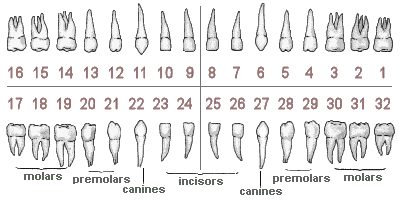Dentists refer to a specific tooth using a number or coding more usually than using teeth names.
There are several teeth numbering systems: the Universal Numbering System (used in US), FDI World Dental Federation notation, and the Palmer Notation Method.
However, for patients it is easier to identify and remember the different teeth by using more descriptive teeth names instead of numbers or other coding.
Teeth names are created by a combination of 4 different characteristics:
- The jaw where they are located: upper and lower (alternatively the terms maxillary and mandibular can be used)
- The side of the face: left and right
- The type of tooth: incisor, canine, premolar, and molar
- A secondary name for the teeth types that appear more than once in each quadrant of the mouth e.g. central and lateral for incisors, first and second for premolars, first, second, and third for molars.
Based on these characteristics, the teeth names for the permanent dentition are the following (starting from the upper right back tooth and moving anti-clockwise):
Next to its tooth you can see the tooth number based on:
a) the Universal Numbering System (UNS) used in the United States and b) the FDI notation (FDI)
Permanent Teeth Names & Numbers
| Permanent Teeth |
UNS |
FDI |
|
FDI |
UNS |
|
| Upper left third molar |
16 |
28 |
|
18 |
1 |
Upper right third molar |
| Upper left second molar |
15 |
27 |
|
17 |
2 |
Upper right second molar |
| Upper left first molar |
14 |
26 |
|
16 |
3 |
Upper right first molar |
| Upper left second premolar |
13 |
25 |
|
15 |
4 |
Upper right second premolar |
| Upper left first premolar |
12 |
24 |
|
14 |
5 |
Upper right first premolar |
| Upper left canine |
11 |
23 |
|
13 |
6 |
Upper right canine |
| Upper left lateral incisor |
10 |
22 |
|
12 |
7 |
Upper right lateral incisor |
| Upper left central incisor |
9 |
21 |
|
11 |
8 |
Upper right central incisor |
| |
|
|
|
|
|
|
| Lower left central incisor |
24 |
31 |
|
41 |
25 |
Lower right central incisor |
| Lower left lateral incisor |
23 |
32 |
|
42 |
26 |
Lower right lateral incisor |
| Lower left canine |
22 |
33 |
|
43 |
27 |
Lower right canine |
| Lower left first premolar |
21 |
34 |
|
44 |
28 |
Lower right first premolar |
| Lower left second premolar |
20 |
35 |
|
45 |
29 |
Lower right second premolar |
| Lower left first molar |
19 |
36 |
|
46 |
30 |
Lower right first molar |
| Lower left second molar |
18 |
37 |
|
47 |
31 |
Lower right second molar |
| Lower left third molar |
17 |
38 |
|
48 |
32 |
Lower right third molar |
Left and Right on the chart correspond to the patient's left and right respectively (patient's view).
Primary (Baby or Deciduous) Teeth Names & Numbers
For primary teeth, most dentists in United States use a modified version of the Universal Numbering System, with each primary tooth assigned a letter (from A to T) instead of a number.
| Primary Teeth |
UNS |
FDI |
|
FDI |
UNS |
|
| Upper left second molar |
J |
65 |
|
55 |
A |
Upper right second molar |
| Upper left first molar |
I |
64 |
|
54 |
B |
Upper right first molar |
| Upper left canine |
H |
63 |
|
53 |
C |
Upper right canine |
| Upper left lateral incisor |
G |
62 |
|
52 |
D |
Upper right lateral incisor |
| Upper left central incisor |
F |
61 |
|
51 |
E |
Upper right central incisor |
| |
|
|
|
|
|
|
| Lower left central incisor |
O |
71 |
|
81 |
P |
Lower right central incisor |
| Lower left lateral incisor |
N |
72 |
|
82 |
Q |
Lower right lateral incisor |
| Lower left canine |
M |
73 |
|
83 |
R |
Lower right canine |
| Lower left first molar |
L |
74 |
|
84 |
S |
Lower right first molar |
| Lower left second molar |
K |
75 |
|
85 |
T |
Lower right second molar |
Left and Right on the chart correspond to the patient's left and right respectively (patient's view).
Other common teeth names:
- Cuspids: Another name for canines
- Bicuspids: Another name for premolars
- 6 year molar: Another name for first molar
- 12 year molar: Another name for second molar
- Wisdom Teeth: A popular name for the third molars
- Anterior Teeth: The teeth in the front of the mouth including central incisors, lateral incisors, and canines.
- Posterior Teeth: The teeth in the back of the mouth including premolars and molars.
- Mandibular Teeth: The teeth on the lower jaw
- Maxillary Teeth: The teeth on the upper jaw



